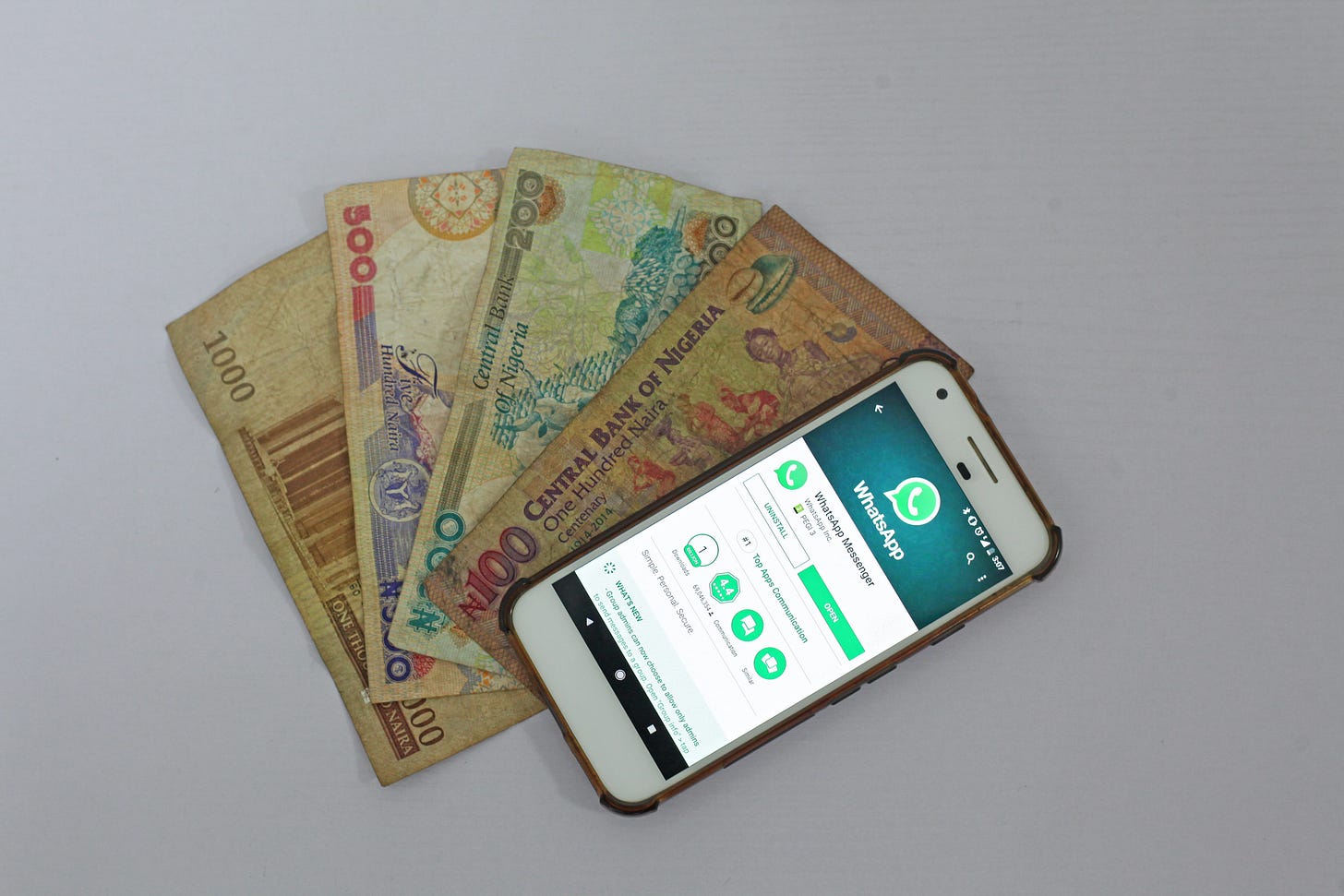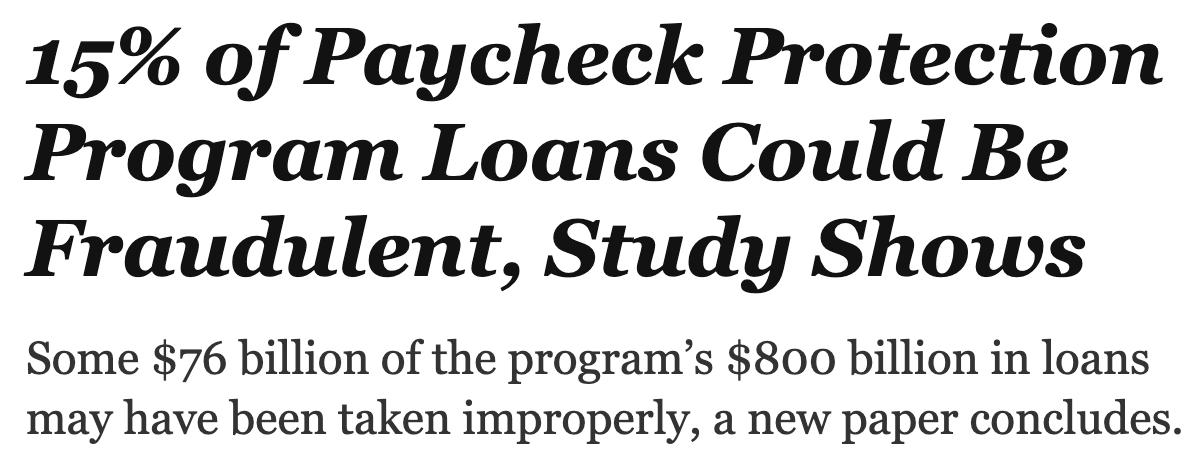Facebook's Coming Currency and Its Banking History No One Remembers
Plus, was fintech PPP fraud all that bad?

Number of the Week: 25.5% (explanation below)
Facebook’s Coming Currency and Its Banking History No One Remembers
It’s coming! The not-entirely-Facebook-led-cryptocurrency-formerly-known-as-Libra is coming soon!
Or is it? On August 16, The Block’s Frank Chaparro (subscription required) reported that Novi, the cryptowallet that is supposed to help people hold and spend the Facebook-backed, yet-to-launch stablecoin Diem, was trying to find another coin to work with. The reason, Chaparro said, is that Novi is running into regulatory hurdles (which would not be hugely surprising, given all the grumbling from US regulators about stablecoins lately). An unnamed source told Chaparro that the Diem Association, which is supposed to oversee the Diem payment network, is now “effectively a zombie organization.” According to Chaparro, the Diem Association has yet to begin minting Diem stablecoins, despite a triumphant announcement in May that Silvergate Capital would be the exclusive issuer and manager of the Diem coin.
On the morning of the 17th, Silvergate’s stock began to tumble, and as of August 20’s close was still down more than 9% from where it was before Block’s story published. (Still, FIN can’t find a mainstream media outlet that’s confirmed the story, or even picked it up.) On August 18, Novi’s head David Marcus published a long, earnest defense of Diem and Novi, promising that everything is fine:
Novi is ready to come to market. It’s regulated, and we’re confident in our operational ability to exceed the high standards of compliance that will be demanded of us. We feel that it’s unreasonable to delay delivering the benefits of cheaper, interoperable, more accessible digital payments.
Marcus is a credible person who has been with the Facebook currency efforts from the beginning; for the moment most people are taking his word that Diem/Novi will launch soon, presumably before the end of the year. Whether it will have much impact is another question.
The whole Diem exercise highlights a curious aspect of the West’s current heated attempts to build a “superapp”, as well as a financial path for Facebook that might have been, but wasn’t. Accept for the sake of argument that masses of customers want to consolidate the money-connected (and other) services they currently use on their phone into a single one-stop app. Then think about the mobile “banking” landscape, say, five or ten years ago. PayPal, not exactly a bank, was around and a market leader; Square, Stripe and Zelle were nascent, as were loan companies like SoFi; big national banks were putting out primitive apps. But no single financial company was anywhere near dominating the space to a point where you would put down your digital chips and say “Yeah, that’s the financial superapp of the future.”
Instead, the thinking in the earlier part of this century was: don’t build a financial app and draw users to it—better to build a financial app on top of where users already are—which means Facebook.
Recently FIN interviewed Zor Gorelov, the cofounder and CEO of Kasisto, a New York-based software company that creates interactive financial services. The firm recently announced a $15 million Series C fundraising round; NCR is both a strategic partner and an investor.
Gorelov recalled that not long ago, many of the biggest financial players looked to Facebook Messenger as a banking and payments platform. In 2016, for example, TechCrunch excitedly reported that
MasterCard account holders will soon be able to check on their accounts, track their spending, review past purchases and more right in Facebook Messenger. That’s right – MasterCard is the latest company to embrace Facebook’s chatbot platform as a new means of interacting with its customers in an automated, but A.I.-enhanced way.
As recently as 2017, Citigroup launched a Facebook Messenger chatbot pilot in Singapore; American Express and PayPal also wanted to join the Facebook Messenger financial space. Gorelov can easily rattle off these examples because Kasisto was involved in most of them. With Facebook’s billions of users, it’s not hard to see the appeal.
And yet, do you know anyone who currently uses Facebook for payments or banking? True, Marcus’s blog post is quick to remind us, Facebook is still a player in the payments space, with $100 billion in payments volume conducted over the last four quarters. (A good chunk of that is presumably through WhatsApp, which is a bigger player in many of the largest non-US markets; in May, for example, WhatsApp relaunched its money transfer program in Brazil, after the central bank for a time had banned it.) Even so, fees from payments make up less than 3% of Facebook’s overall revenue.
Why did Facebook’s financial platform plans slow down to a crawl? Gorelov has a simple explanation: “But then Cambridge Analytica happened and all the banks very quickly walked away.”
It’s a fascinating connection that’s not often seen: Facebook was arguably on a trajectory in the financial space to create the first non-Chinese superapp. But more than any other service, handling people’s money requires customer trust, and the Cambridge Analytica scandal shattered Facebook’s trust. Perhaps Diem can help restore that, but it’s an uphill climb.
Was Fintech PPP Fraud Really All That Bad?
For an academic paper not about climate change or COVID-19, the 95-page study “Did FinTech Lenders Facilitate PPP Fraud?” released this week had quite a public impact, although that didn’t necessarily make its findings well understood. The New York Times, which clearly received an advance copy, went with this headline and deck:
Here’s the first disconnect: $76 billion out of $800 billion is 9.5%, not 15%. Reading the story, you learn that the 15% figure refers to the number of loans, not their value, so it’s “accurate,” but still—why put an apparent mathematical contradiction at the top of the story?
Here’s a second disconnect: The Times’ very defensible summary of the paper is:
The study pins blame for many of the questionable loans on one particular group of lenders: financial technology firms, known as “fintechs,” which focus on digital lending. Nine of the 10 lenders with the highest rate of suspicious loans fell into that group.
“Certain fintech lenders seem to specialize in dubious loans,” the authors wrote. Collectively, fintechs made around 29 percent of the program’s loans but accounted for more than half of its suspicious loans, the study concluded.
That sounds serious, doesn’t it? And yet, maybe those aren’t the actual numbers, because the research made a bunch of assumptions that could create some wide variations. The Times goes on to explain: “A more restrictive calculation by the researchers, of loans with at least two suspicious characteristics, identified 1.2 million potentially fraudulent loans, totaling $38 billion.”
$38 billion out of $800 billion is 4.75% which—not to be cavalier about the seriousness of PPP fraud—does not seem wholly out of whack with what must be standard for quickly delivered federal government programs of this size.
And indeed, when the first round of PPP loans came out, there were at least two samples that showed a much higher percentage of potentially fraudulent loans emanating from fintechs. In October, for example, Bloomberg reported: “Financial technology companies handled 75% of the approved PPP loans that have been connected to fraud by the U.S. Department of Justice, a Bloomberg analysis of more than 100 loans at the center of the cases shows.”
So chalk up a third disconnect: the Times story (and those that followed it) could just have legitimately carried a headline like “Study Finds Far Smaller Percentage of Fintech PPP Fraud Than Previous Estimates.”
That fintech companies and the Small Business Administration allowed some coordinated PPP fraud (as opposed to mistakes, or individual fraud) is undeniable; the evidence is as comical as it is persuasive. In May, ProPublica published an investigative feature detailing hundreds of PPP loans to fake companies, most of them pretending to be farms with names like “Beefy King” and “Deely Nuts.” The University of Texas report also showed more than a dozen loans for nearly identical amounts registered to a single-family home in a Chicago suburb:
(The fintech lender Kabbage, now owned by American Express, features prominently in both the study and the ProPublica report. Kabbage didn’t respond to a FIN request for comment, but in the ProPublica piece the company insisted that it adhered to fraud protocols and reported any fraud to the government.)
One of the paper’s nuanced findings that didn’t make it into mainstream coverage is the authors’ belief that the PPP fraud didn’t seem to be intrinsically connected to fintech. They noted that both Intuit and Square issued a large number of loans, but relatively few of them seemed suspicious. Rather, a handful of very opportunistic companies, notably Blueacorn and Womply, appear to have taken advantage of rolling changes in the law to collect millions in fees very quickly.
Indeed, one of the most important contributions of the UofT paper is that it incorporates data from 2021 and not just 2020. Between the two PPP phases there were important changes, including a huge increase in the amounts that lenders could collect in fees, and an extension of eligibility to include sole proprietors and gig workers.
For example, FIN wrote back in March about BlueVine, a fintech lender making PPP loans available to Lyft drivers and other sole proprietors; that was the outcome of a legislative shift that had taken place only a few weeks earlier. (BlueVine, for what it’s worth, claims to have facilitated 3% of all PPP loans, yet it doesn’t show up in the study’s top 75 PPP lenders, so that’s another disconnect. BlueVine’s publicist didn’t return an e-mail seeking comment.)
While it’s important to weed out fraud—and of course all the companies and agencies involved say that they made good efforts—there are a couple of broader policy points worth making here. First, the time frame for rolling out these crucial legislative changes—such as the extension of PPP loans to sole proprietors—was extremely condensed. It’s far from clear that the federal government on its own was well-positioned to get the word out fast to those communities, and so reliance on opportunists like Womply was one of very few alternatives. Second, PPP loans (and their forgiveness) were designed as stimulus, not as need- or merit-based grants. While obviously having a fraudster take a loan that could have gone to a deserving business is a policy failure, it’s not clear that the supply of funds available was the biggest barrier to deserving businesses getting loans; most evidence points to awareness and the complexity of applying. From a macroeconomic perspective, though, stimulus is fairly forgiving on such matters; if a fraudulent PPP recipient goes out and spends the money on a new pickup truck, the economic effect is presumably similar to the same expenditure from a real business. As for the truly bad guys, it would be nice to believe that the SBA will go knocking on the door of that house outside Chicago.
FINvestments
🦈Number of the Week: Robinhood had its first earnings announcement this week as a public company. It reported that 25.5% of its quarterly revenue came from Dogecoin trading. The stock fell dramatically; maybe payment for order flow wasn’t so bad after all!
🦈It was strange to see the announcement this week that Chime has raised $750 million in a Series G round. Not because the company (even with its nightmarish customer issues) seems like a cold investment prospect, but because its CEO told Reuters in March that Chime had more than $1 billion cash in the bank and “does not need to raise additional capital soon.” Is five months not “soon”? Or was the raise unnecessary?







> Still, FIN can’t find a mainstream media outlet that’s confirmed the story, or even picked it up.
David Marcus did a Bloomberg TV interview about this where the interviewer asked him about all the stuff in the Block article, including Novi using stablecoins other than Diem. Marcus said that would only be a last resort - he notably did not deny the claims.